 |
|
|||||||
Workbook for Designing, Implementing, and Evaluating a Sharps Injury Prevention Program |
|||||||
Contents: |
||||||||||||||||||||||||||||||||||||||||||||||||||||||||||||||||||||||
| |
OVERVIEW: RISKS AND PREVENTION OF SHARPS INJURIES IN HEALTHCARE PERSONNELIntroductionPrevention of percutaneous injuries and other blood exposures is an important step in preventing the transmission of bloodborne viruses to healthcare personnel. Epidemiologic data on sharps injury events, including the circumstances associated with occupational transmission of bloodborne viruses, are essential for targeting and evaluating interventions at the local and national levels. The CDC estimates that each year 385,000 needlesticks and other sharps-related injuries are sustained by hospital-based healthcare personnel; an average of 1,000 sharps injuries per day (1). The true magnitude of the problem is difficult to assess because information has not been gathered on the frequency of injuries among healthcare personnel working in other settings (e.g., long-term care, home healthcare, private offices). In addition, although CDC estimates are adjusted for it, the importance of underreporting must be acknowledged. Surveys of healthcare personnel indicate that 50% or more do not report their occupational percutaneous injuries (4-7). Bloodborne Virus Transmission to Healthcare PersonnelInjuries from needles and other sharp devices used in healthcare and laboratory settings are associated with the occupational transmission of more than 20 pathogens (2,3,8-10). HBV, HCV, and HIV are the most commonly transmitted pathogens during patient care (Table 1).  Hepatitis B VirusNational hepatitis surveillance provides yearly estimates of HBV infections in healthcare personnel. These estimates are based on the proportion of persons with new infections who report frequent occupational blood contact. CDC estimated that 12,000 HBV infections occurred in healthcare personnel in 1985 (11). Since then, the number has declined steadily, down to an estimated 500 in 1997 (12). The decline in occupational HBV-more than 95%-is due largely to the widespread immunization of healthcare personnel. Although universal precautions also help reduce blood exposures and HBV infections in healthcare personnel (13-15), the extent of their contribution cannot be precisely quantified. Most healthcare personnel today are immune to HBV as the result of pre-exposure vaccination (16-21). However, susceptible healthcare personnel are still at risk for needlestick exposure to an HBV-positive source. Without postexposure prophylaxis, there is a 6%-30% risk that an exposed, susceptible healthcare worker will become infected with HBV (22-24). The risk is highest if the source individual is hepatitis B e antigen positive, a marker of increased infectivity (22). Hepatitis C VirusBefore the implementation of universal precautions and the discovery of HCV in 1990, an association was noted between employment in patient care or laboratory work and acquiring acute non-A, non-B hepatitis (25). One study showed an association between anti-HCV positivity and a history of accidental needlestick exposures (26). The precise number of healthcare personnel who acquire HCV occupationally is not known. Healthcare personnel exposed to blood in the workplace represent 2% to 4% of the total new HCV infections occurring annually in the United States (a total that has declined from 112,000 in 1991 to 38,000 in 1997) (27, CDC, unpublished data). However, there is no way to confirm that these are occupational transmissions. Prospective studies show that the average risk of HCV transmission following percutaneous exposure to an HCV-positive source is 1.8% (range: 0% -7%) (28-33), with one study indicating that transmission occurred only from hollow-bore needles compared with other sharps (28) A number of case reports also document occupational HCV transmission to healthcare personnel (34-40). All except two involve percutaneous injuries: one case of HCV and another of HCV and HIV transmission via splash to the conjunctiva (39, 40). To date, no transmission in healthcare personnel has been documented through intact or non-intact skin HCV blood exposure. However, one case of HIV and HCV transmission from a nursing home patient to a health care worker is thought to have occurred through a non-intact skin exposure (41). Human Immunodeficiency VirusThe first case of HIV transmission from a patient to a healthcare worker was reported in 1986 (42). Through December, 2001, CDC had received voluntary reports of 57 documented and 138 possible episodes of HIV transmission to healthcare personnel in the United States ( http://www.cdc.gov/ncidod/hip/BLOOD/hivpersonnel.htm/). In prospective studies of healthcare personnel, the average risk of HIV transmission after a percutaneous exposure is estimated to be approximately 0.3% (10). In a retrospective case-control study of healthcare personnel with percutaneous exposure to HIV, the risk for HIV infection was found to be increased with exposure to a larger quantity of blood from the source person as indicated by a) a device visibly contaminated with the patient's blood, b) a procedure that involves placing a needle directly in the source patient's vein or artery, or c) a deep injury (43). Of the 57 documented cases of HIV transmission to healthcare personnel in the United States, most involve exposure to blood through a percutaneous injury, usually with a hollow-bore needle that was in a blood vessel (vein or artery) (CDC, unpublished data). The average risk for occupational HIV transmission after a mucous-membrane exposure is estimated to be 0.09% (44). Although episodes of HIV transmission after skin exposures are documented (45), the average risk for transmission has not been precisely quantified but is estimated to be less than the risk mucous-membrane exposures (46). Cost of Needlestick InjuriesAlthough occupational HIV and hepatitis seroconversion is relatively rare, the risks and costs associated with a blood exposure are serious and real. Costs include the direct costs associated with the initial and follow-up treatment of exposed healthcare personnel, which are estimated to range from $500 to $3,000 depending on the treatment provided (47). Costs that are harder to quantify include the emotional cost associated with fear and anxiety from worrying about the possible consequences of an exposure, direct and indirect costs associated with drug toxicities and lost time from work, and the societal cost associated with an HIV or HCV seroconversion; the latter includes the possible loss of a worker's services in patient care, the economic burden of medical care, and the cost of any associated litigation. Epidemiology of Needlesticks and Other Sharps-related InjuriesData on needlesticks and other sharps-related injuries are used to characterize the who, where, what, when, and how of such events. Aggregated surveillance data from the National Surveillance System for Health Care Workers (NaSH) are used here to provide a general description of the epidemiology of percutaneous injuries. Similar statistics from hospitals participating in the Exposure Prevention Information Network (EPINet) system, developed by Dr. Janine Jagger and colleagues at the University of Virginia, may be found on the International Health Care Worker Safety Center website http://www.med.virginia.edu/epinet/soi01.html. Who is at Risk of Injury?Data from NaSH show that nurses sustain the highest number of percutaneous injuries. However, other patient-care providers (e.g., physicians, technicians), laboratory staff, and support personnel (e.g., housekeeping staff), are also at risk (Figure 1). Nurses are the predominant occupational group injured by needles and other sharps, in part because they are the largest segment of the workforce at most hospitals. When injury rates are calculated based on the number of employees or full-time equivalent (FTE) positions, non-nursing occupations sometimes have a higher rate of injury (Table 2). Where, When and How Do Injuries Occur?Although sharp devices can cause injuries anywhere within the healthcare environment, NaSH data show that the majority (40%) of injuries occur on inpatient units, particularly medical floors and intensive care units, and in operating rooms (Figure 2). Injuries most often occur after use and before disposal of a sharp device (41%), during use of a sharp device on a patient (39%), and during or after disposal (16%).(CDC unpublished data) There are many possible mechanisms of injury during each of these periods as shown in NaSH data on hollow-bore needle injuries (Figure 3). 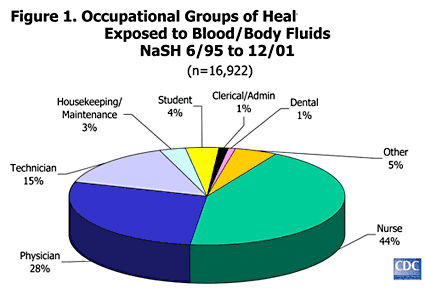  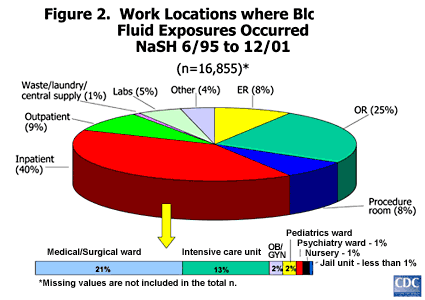 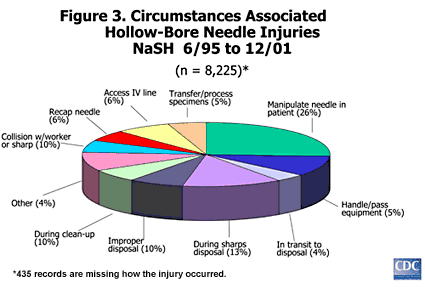 What Devices Are Involved in Percutaneous Injuries?Although many types of sharps injure healthcare personnel, aggregate data from NaSH indicates that six devices are responsible for nearly eighty percent of all injuries (Figure 4). These are:
Overall, hollow-bore needles are responsible for 59% of all sharps injuries in NaSH. 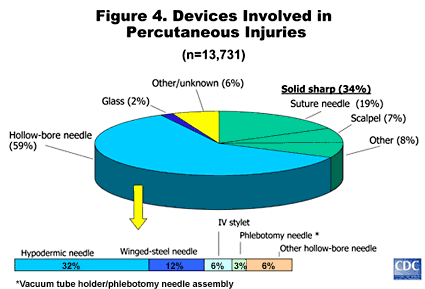 Device-related factors also influence percutaneous injury risks. A 1988 article by Jagger et al. (52) demonstrates that devices requiring manipulation or disassembly after use (such as needles attached to IV tubing, winged steel needles, and IV catheter stylets) were associated with a higher rate of injury than the hypodermic needle or syringe. 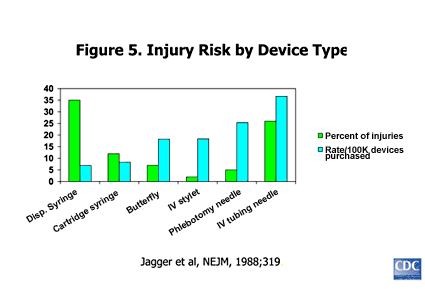 Importance of Hollow-bore Needle InjuriesOf particular concern are injuries from hollow-bore needles, especially those used for blood collection or IV catheter insertion. These devices are likely to contain residual blood and are associated with an increased risk for HIV transmission (43). Of the 57 documented cases of occupational HIV transmission to healthcare personnel reported to CDC through December 2001, 50 (88%) involve a percutaneous exposure. Of these, 45 (90%) were caused by hollow-bore needles, and half of these needles were used in a vein or an artery (CDC, unpublished data). Similar injuries are seen in occupational HIV transmission in other countries (53). Although two scalpel injuries (both in the autopsy setting) caused HIV seroconversions (CDC, unpublished data), solid sharps, such as suture needles, generally deliver a smaller blood inoculum, especially if they first penetrate gloves or another barrier (54). Therefore, these devices theoretically pose a lower risk for HIV transmission. Similar descriptive data are not available for the types of devices or exposures involved in the transmission of HBV or HCV. Sharps Injuries in the Operating RoomAmong NaSH hospitals, the operating room is the second most common environment in which sharps injuries occur, accounting for 25% of injuries overall(CDC, unpublished data). However, the epidemiology of sharps injuries in the operating room differs from that in other hospital locations. Observational studies of operative procedures have recorded some type of blood exposure to healthcare personnel in 7% to 50% of exposures; in 2% to 15% of exposure, the event is a percutaneous injury-usually from a suture needle (55-59). Aggregate data from nine hospitals on injuries among operating room staff also reflect the importance of suture needles, which in this study account for 43% of the injuries (60). Injury Prevention StrategiesHistorical Perspective and Rationale for a Broad-Based Strategy for Preventing Sharps InjuriesIn 1981, McCormick and Maki first described the characteristics of needlestick injuries among healthcare personnel and recommended a series of prevention strategies, including educational programs, avoidance of recapping, and better needle disposal systems (48). In 1987, CDC's recommendations for universal precautions included guidance on sharps injury prevention, with a focus on careful handling and disposal of sharp devices (61). Several reports on needlestick prevention published between 1987 and 1991 focused on the appropriate design and convenient placement of puncture-resistant sharps disposal containers and the education of healthcare personnel on the dangers of recapping, bending, and breaking used needles (62-68). Most of these studies documented only limited success of specific interventions to prevent disposal-related injuries and injuries due to recapping (51,64-67). Greater success in decreasing injuries was reported if the intervention included an emphasis on communication (62,68). Universal (now standard) precautions is an important concept and an accepted prevention approach with demonstrated effectiveness in preventing blood exposures to skin and mucous membranes (13,14). However, it focuses heavily on the use of barrier precautions (i.e., personal protective practices) and work-practice controls (e.g., care in handling sharp devices) and by itself could not be expected to have a significant impact on the prevention of sharps injuries. Although personal protective equipment (e.g., gloves, gowns) provide a barrier to shield skin and mucous membranes from contact with blood and other potentially infectious body fluids, most protective equipment is easily penetrated by needles. Thus, although strategies used to reduce the incidence of sharps injuries (e.g., rigid sharps disposal containers, avoidance of recapping) a decade or more ago remain important today, additional interventions are needed. Current Prevention ApproachesIn recent years, healthcare organizations have adopted as a prevention model the hierarchy of controls concept used by the industrial hygiene profession to prioritize prevention interventions. In the hierarchy for sharps injury prevention, the first priority is to eliminate and reduce the use of needles and other sharps where possible. Next is to isolate the hazard, thereby protecting an otherwise exposed sharp, through the use of an engineering control. When these strategies are not available or will not provide total protection, the focus shifts to work-practice controls and personal protective equipment. Since 1991, when OSHA first issued its Bloodborne Pathogens Standard (69) to protect healthcare personnel from blood exposure, the focus of regulatory and legislative activity has been on implementing a hierarchy of control measures. This has included giving greater attention to removing sharps hazards through the development and use of engineering controls. By the end of 2001, 21 states had enacted legislation to ensure the evaluation and implementation of safer devices to protect healthcare personnel from sharps injuries ( http://www.cdc.gov/niosh/ndl-law.htm). Also, the federal Needlestick Safety and Prevention Act signed into law in November, 2000 (Current Prevention Approaches) authorized OSHA's recent revision of its Bloodborne Pathogens Standard to more explicitly require the use of safety-engineered sharp devices. (http://www.osha.gov/SLTC/bloodbornepathogens/ index.html) Alternatives to Using Needles. Healthcare organizations can eliminate or reduce needle use in several ways. The majority (~70%) of U.S. hospitals (70) have eliminated unnecessary use of needles through the implementation of IV delivery systems that do not require (and in some instances do not permit) needle access. (Some consider this a form of engineering control described below.) This strategy has largely removed needles attached to IV tubing, such as that for intermittent ("piggy-back") infusion, and other needles used to connect and access parts of the IV delivery system. Such systems have demonstrated considerable success in reducing IV-related sharps injuries (71-73). Other important strategies for eliminating or reducing needle use include:
Engineering Controls. Engineering controls remove or isolate a hazard in the workplace. In the context of sharps injury prevention, engineering controls include sharps disposal containers and needles and other sharps devices with an integrated engineered sharps injury prevention feature. The emphasis on engineering controls has led to the development of many types of devices with engineered sharps injury prevention features (74-78) and there are suggested criteria for the design and performance of such devices (52). These criteria propose that the safety feature should accomplish the following:
Moreover, features designed to protect healthcare personnel should not compromise patient care (79). Relatively few studies are published that systematically assess the effectiveness of safety devices in reducing percutaneous injuries (other than those involving needle-free IV systems), despite the proliferation of these devices (Table 3). Reports that are available show considerable variation in study methodology, measurement of outcomes, and efficacy. Also, there are apparent differences in efficacy by type of device. Table 3. Effectiveness of devices with sharps injury prevention features and other sharps injury prevention measures
* PI = percutaneous injuries In 1998, OSHA published a Request for Information in the Federal Register on "engineering and work practice controls used to minimize the risk of occupational exposure to bloodborne pathogens due to percutaneous injuries from contaminated sharps." There were 396 responses to this request; several respondents provided data and anecdotal information on their experiences with safety devices. (http://www.osha.gov/html/ndlreport052099.html) Research suggests that no single safety device or strategy works the same in every facility. In addition, no standard criteria exist for evaluating safety claims, although all major medical device manufacturers market devices with safety features. Therefore, employers must develop their own programs to select the most appropriate technology and evaluate the effectiveness of various devices in their specific settings. Work-practice Controls. With the current focus on engineered technology, there is little new information on the use of work-practice controls to reduce the risk of sharps injuries during patient care. One exception is the operating room. Work-practice controls are an important adjunct for preventing blood exposures, including percutaneous injuries, in surgical and obstetrical settings because the use of exposed sharps cannot be avoided. Operating room controls include:
The use of blunt suture needles, an engineering control, is also shown to reduce injuries in this setting (89). These measures help protect both the healthcare provider and patient from exposure to the other's blood (90). Multi-component Prevention ApproachesExperts agree that safety devices and work practices alone will not prevent all sharps injuries (85, 90-95). Significant declines in sharps injuries also requires:
One report detailed a program to decrease needlestick injuries that involves simultaneous implementation of multiple interventions:
This strategy showed an immediate and sustained decrease in needlestick injuries, leading researchers to conclude that a multi-component prevention approach can reduce sharps injuries. Organizational FactorsSome industrial sectors are finding that a strong safety culture correlates with: productivity, cost, product quality, and employee satisfaction (96). Organizations with strong safety cultures consistently report fewer injuries than organizations with weak safety cultures. This happens not only because the workplace has well-developed and effective safety programs, but also because management, through these programs, sends cues to employees about the organization's commitment to safety. The concept of institutionalizing a culture of safety is relatively new for the healthcare industry and there is limited literature on the impact of such efforts. However, a recent study in one healthcare organization linked measures of safety culture with both employee compliance with safe work practices and reduced exposure to blood and other body fluids, including reductions in sharps-related injuries (97). System analysis strategies, used by many healthcare organizations to improve patient safety, also can be applied to the prevention of sharps-related injuries to healthcare personnel. These strategies include the following:
Detailed information on these and other systems approaches to patient safety may be found at http://www.patientsafety.gov. Healthcare Personnel AcceptanceHealthcare personnel have difficulties changing long-standing practices. This observation is borne out by studies conducted in the years following implementation of universal precautions, when observed compliance with recommended practices was not satisfactory (98-103). The same holds true for devices with safety features-healthcare organizations have difficulty convincing healthcare personnel to adopt new devices and procedures (94). Psychosocial and organizational factors that slow the adoption of safety practices include:
A few authors have applied research methods and behavior-change models from other disciplines to study the acceptability of infection-control strategies (105,106). English used an adult learner model to evaluate needle injuries in hospital personnel and found that knowledge of correct procedures, provision of safe equipment, and proper management predicted compliance with needlestick-prevention precautions (105). Others consider the use of the Health Belief Model to help understand the reluctance to adopt preventive behaviors to decrease sharps injuries, and they suggest that cognitive approaches and behavior modification strategies be incorporated into an overall program to prevent sharps injuries (98, 100). Other models, including the Theory of Reasoned Action and the Theory of Planned Behavior, are recommended when considering a theoretical based intervention for improving practice (98). Further research on how these models will affect sharps injury prevention is needed. The Need for GuidanceAccording to the authors of the American Hospital Association injury prevention guide (95), facilities that have adopted or are adopting safety technologies find the process to be complex and exacting. Successful injury prevention programs require:
Also, although most healthcare organizations recognize the need for an interdisciplinary approach to this complex undertaking, "... few are prepared for the difficulties in attempting to change behavior, the complex logistics of supplies and equipment in a modern hospital, or the methodological and analytical rigors of documenting the impact of safety devices" (93). In November, 1999, CDC/NIOSH issued the NIOSH Alert: Preventing Needlestick Injuries in Healthcare Settings to guide employers and healthcare personnel on strategies for preventing sharps injuries. CDC is providing this workbook, which compliments the CDC/NIOSH Alert, to assist healthcare organizations in their programmatic efforts to improve healthcare personnel safety. |
|||||||||||||||||||||||||||||||||||||||||||||||||||||||||||||||||||||
| CDC
Home - CDC Search - CDC
Health Topics A-Z This workbook developed and maintained by CDC's Division of Healthcare Quality Promotion - (DHQP Home) Privacy Policy - Accessibility Publish date: February 12, 2004 This page last reviewed February 12, 2004 |
||||||||||||||||||||||||||||||||||||||||||||||||||||||||||||||||||||||